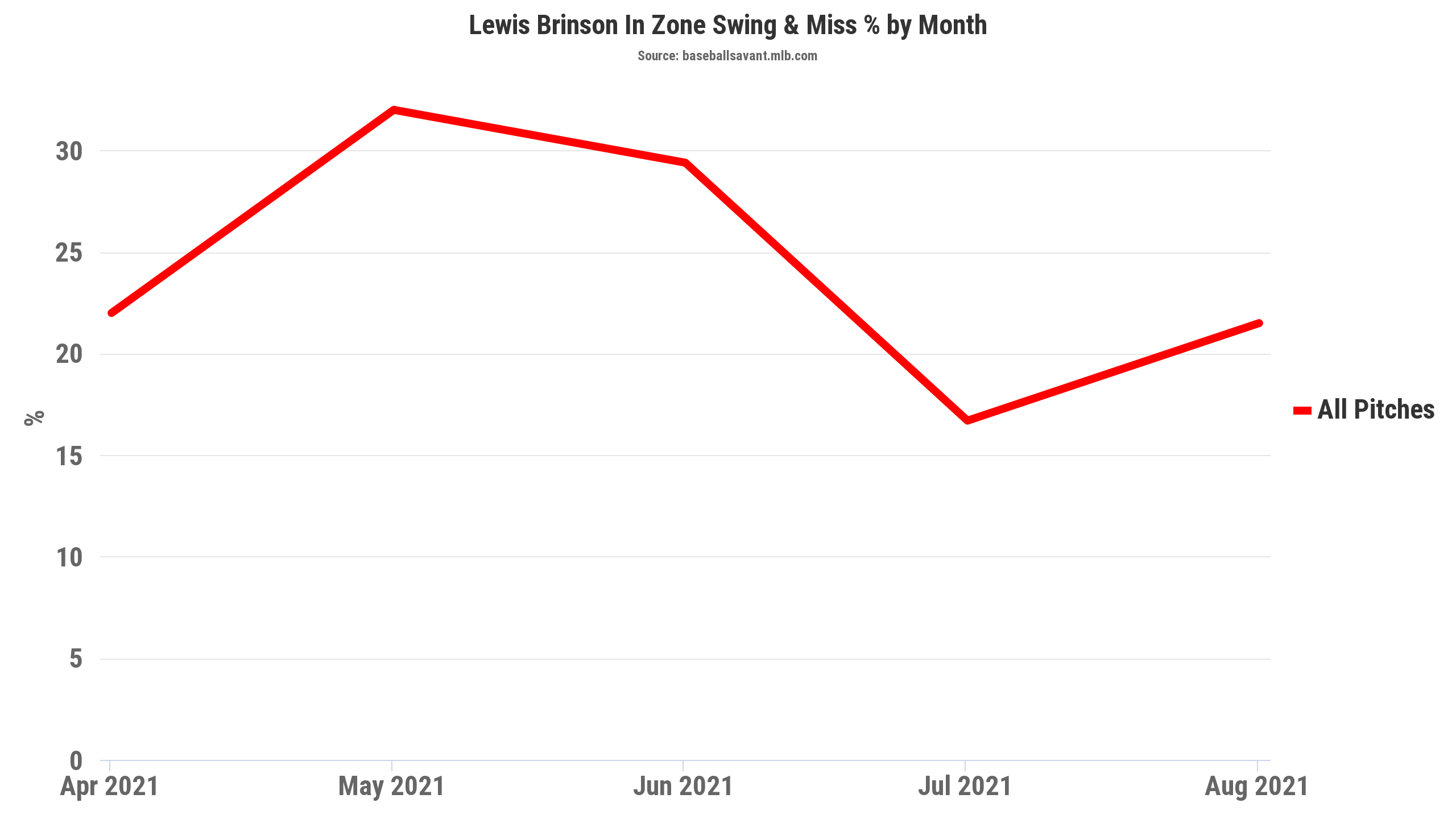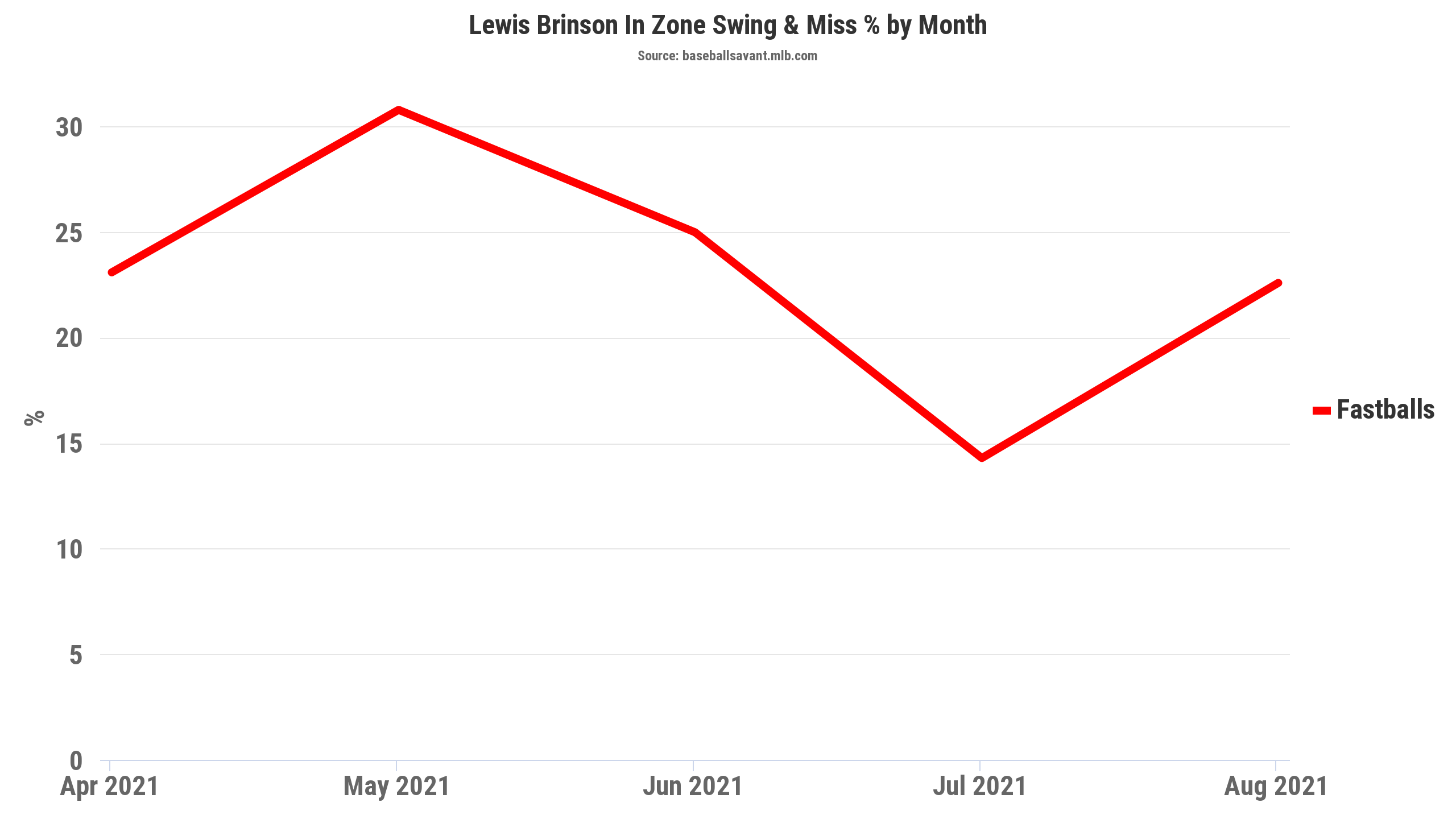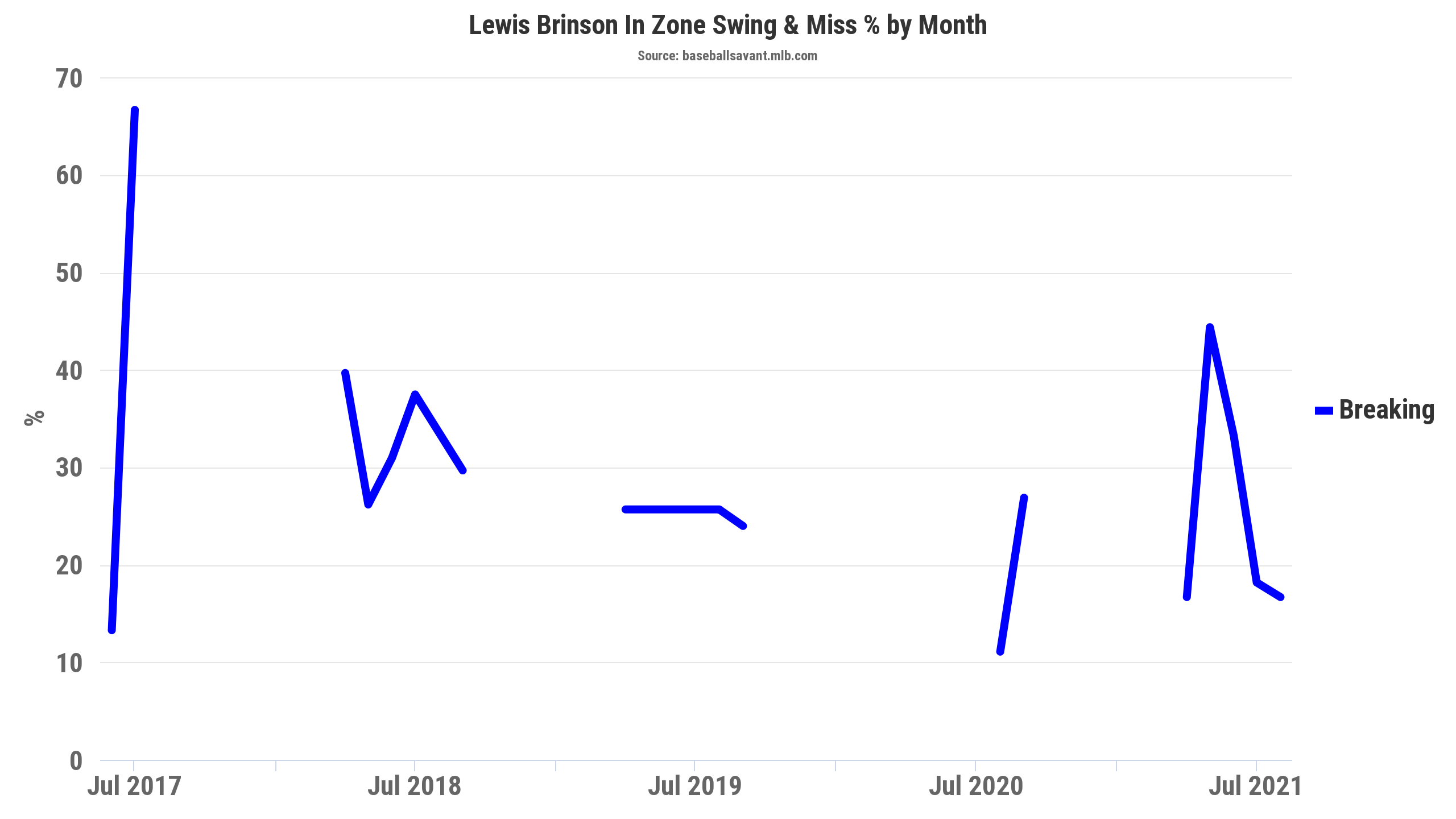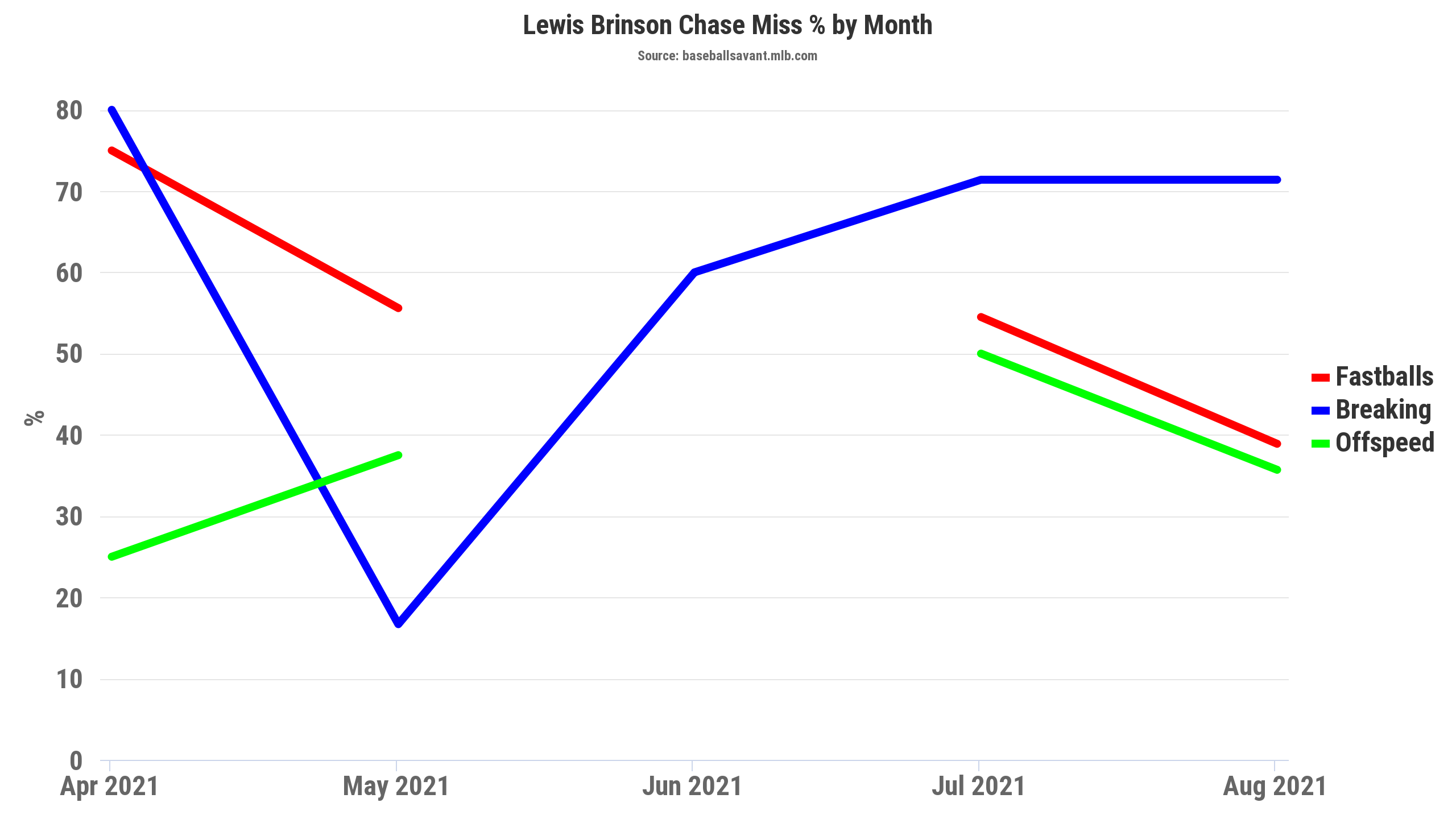With the Miami Marlins on the outside looking in at the postseason, it wasn’t a surprise to see them sell off some of their veteran pieces in the leadup to the trade deadline. They moved three outfielders, the most notable of which being Starling Marte, while also moving the solid corner bats in Adam Duvall and Corey Dickerson as well. This obviously left the team with some holes in their outfield, and they needed to turn to someone in their organization to fill out the roster and get them through the rest of the season. While the team tried to acquire some other notable, younger outfielders to replace their departed veterans, they were unable to and pretty much were left with whatever they had for the remainder of the year, including Lewis Brinson.
Brinson was called up to the Marlins for a whopping fourth time this year on July 19th and was pretty much set into an everyday role for the team from that point on. It may have felt like Einstein’s definition of insanity for Marlins fans in that the team was turning to him yet again and expecting different results, but this time around, things have been different for Brinson, and in a good way. Once upon a time, he was a former consensus top-20 prospect in the game and was the main headliner coming back to Miami in the deal that sent Christian Yelich to the Milwaukee Brewers. Expectations were certainly high for the native South Floridian in Miami, but he hasn’t done much living up to that top-prospect status in his time in the Majors coming into 2021. There’s no other way to describe his performance thus far than as bad. Before 2021, he hit for a .195/.242/.305 triple slash, which translates to a 49 wRC+ and nearly three wins below replacement. Through every lens, this was bad, and it would be fair to expect more of the same from Brinson—he came into his July 19th callup looking like his usual self with a 59 wRC+, after all.
However, Brinson has quietly put up strong results in the time since as one of the league’s hottest hitters and has turned the narrative around for his season, with a mightily impressive .325/.388/.623 slash line since July 19th, which bumps his overall stats for the year up to a very solid .276/.318/.497 and a 121 wRC+. Definitely quite the turnaround. Looking at Brinson’s profile in this stretch, there have definitely been some substantial improvements, as well as some things that still stand out as not being so great. So then, how much can we trust this to be real? What’s been different for Brinson in this nearly month-long hot streak, and is it sustainable? Let’s try and find out.
Hitting the Ball Harder (and Up)
Let’s start with the positives in Brinson’s profile when it comes to looking at his bounce-back hot stretch. Even throughout his struggles at the plate for his career, Brinson has still had decent hard-hit ability. His hard-hit rates have never been super impressive, but his cumulative hard-hit rate of 36.5% from 2018 to 2020 is nearly identical to the league-average rate of 36.3%. What’s been more impressive, though, is that he’s consistently posted strong maximum exit velocities, as he generally ranked towards the top of the league in terms of percentile rank:
Brinson’s strong marks here do show his raw power and strength—two things that were pluses in his prospect reports. A strong maximum exit velocity is still present in his profile this season, with a 2021 mark of 113.2 miles-per-hour, which is just a few ticks off from his career-high and ranks favorably among the rest of the league as it sits inside the 89th percentile. This time around, though, his hard-hit has spiked considerably to a rate that is now well above league-average at 43%, a new career-high. Since his July 19th callup, his hard-hit rate has been a superb 49.1%, which has definitely been a big driving point of his success in this span.
To go along with that, though, Brinson has also been hitting the better batted-ball types—fly balls and line drives—harder than ever, and it’s showing up in the results, with Brinson posting the best results on them since 2018:
Also, unsurprisingly, Brinson has taken off in this department when it comes to looking from July 19th onwards. There have only been six other hitters who have gotten better results in terms of wOBA on their fly balls and line drives in the time since:
This is definitely a good thing, and ultimately, one of the biggest things driving Brinson’s sudden surge. This also is more important, considering Brinson’s groundball rate has taken a turn for the better. He came into the season with a career groundball rate of 51%, which definitely wasn’t helping matters in terms of his poor results. For this season, though, Brinson has a much-improved groundball rate of 44.2%. So, we now have not only a Brinson who is already doing something right in hitting the ball harder, but also one that is hitting it in the air more. These are two things that already give a hitter better odds to succeed, and that does look to be the case for Brinson. Hitting the ball harder and in the air likely explains the career-highs in barrel and sweet spot rate at 8.7% and 33.7%, respectively, as these marks show that Brinson is just generally hitting the ball a lot more efficiently, which is certainly having an impact.
More Contact
The other big thing driving Brinson’s bounce back is that he has improved upon his biggest weakness as a hitter throughout his Major League career—his high strikeout rate. While Brinson was hitting a lot of grounders in the past, that alone wasn’t enough to doom him and cause him to struggle as much as he did. Rather it was the strikeouts, as he had a career strikeout rate of 29.4% coming into the year, which was certainly not going to help him out, especially in combination with the other factors that were holding him down as well. While his strikeout rate for this season as a whole is still a high 26.6%, we again do see things that look different post-July 19th.
From the start of the year up until his most recent call-up, Brinson had a 30.4% strikeout rate, and he even looked to regressing in terms of plate discipline with a minuscule 1.4% walk rate. He’s been walking a lot more in the time since, up to a more respectable 8.2% rate, while his strikeout rate has seen slight improvement by a couple of ticks down to 23.5%. It’s been even better since the start of August, in particular, with his strikeout rate at a much better looking 18.3%. Are we sure that we’re still talking about the same hitter? It really has been something to behold, but at the same time, it is still too early to say that this lower rate is here to stay. However, what’s important regarding Brinson’s improvement here is that he’s been making a lot more contact on pitches inside the strike zone:

He’s gone from the super-highs of nearly 30% in May and June to a much better 21.5% in August and an even better 16.5% in July. As it turns out, both July and August of this year are two of Brinson’s lowest single-month In-Zone Whiff rate months in his career (minimum 90 pitches seen in the month):
A good bit of that improvement has to do with more contact on fastballs inside the zone, an area in which Brinson uncharacteristically struggled with earlier in the year:

For whatever reason, Brinson seemed to struggle at making consistent contact on fastballs inside the strike zone earlier in the year, with sky-high whiff rates of 30% in both May and June—two of the highest single-season in-zone whiff rates on fastballs for his career.
However, the majority of the improvement in this area comes from making more contact on breaking balls, as Brinson has done a complete 180 here from not only where he was earlier in the season but previously in his career:

This is key because Brinson has struggled big-time with breaking balls throughout his career, so if this turnaround ends up being legitimate, it could really be the start of something new for him, as he has generally been much better at hitting fastballs over the years than the other pitch types. To go along with more contact in the zone on breaking pitches, Brinson has been making better contact, which was to be expected considering his overall batted-ball improvements detailed earlier, and with that, better results on breaking balls now compared to where he once was:
Considering his previous struggles here, this certainly looks to be a positive step forward for Brinson and another big part of what has been driving his success lately. With these numbers being even better in the last month or so, as Brinson’s wOBA and SLG numbers on breakers in the zone have increased to .646 and 1.088, respectively, during that time, which ranks among the highest in baseball.
The Chases
All of the talk in the last section had more to do with Brinson’s results inside the strike zone, though, and not exactly on the things that are happening outside of it. It is still good to see Brinson having increased success there, of course, but there is still something in his profile that seems like a glaring red flag and could be the biggest determiner in whether or not this sudden hot surge is legitimate. Brinson is still chasing a ton of pitches outside of the zone, which may ultimately limit his true upside.
Brinson’s chase rate for the season is a high 39.5%, which for context, ranks in the top-20 among the entire league. It is true that his chase rate is inflated some due to his extremely rough start to the year, but even during his recent hot run of form, his chase rate has still been much higher than league-average:
Note that we can largely ignore June in this, as Brinson received just ten plate appearances at the Major League level that month. But while we do see gradual improvement from Brinson in this department, which is positive, it’s still not so great. It’s certainly better than the starting point, but it’s still a long way away from being considered good, as even his best months (again excluding June) are still almost ten percentage points higher than the rest of the league.
What also seems like an issue is that while Brinson has made more contact on pitches inside the zone, those gains have yet to translate to pitches outside of the zone. His rate of contact on chases has dropped from the last two seasons to 49.6%, which is well below the league-average mark of 58.6%. On top of that, when Brinson expands the zone, those pesky breaking balls become an issue again, with Brinson missing them by far the most of the three pitch-type groups:

It does perhaps seem odd to harp on a lack of contact on pitches outside the zone considering that we usually don’t want to see hitters chasing all that much in the first place, but for Brinson, he has such a high chase rate, which is something that is unlikely to change all that much. It’s just a part of his game, and that can definitely lead to more strikeouts, as we’ve seen previously in his career. He looks to have figured out something in terms of making more contact in the zone, but with a high rate of chases and making less contact on those chases, he could still be in danger of having a higher strikeout rate and potentially offset some of those in-zone contact rate gains.
Interestingly enough, though, when Brinson actually does make contact on those pitches outside the zone, he’s done extremely well. He has one of the highest wOBACON and xwOBACON marks among all hitters this season on pitches in the “chase” and “waste” zones as defined by Statcast:
It seems like Brinson has been a good bad-ball hitter this season, but it’s probably not all that sustainable. He’s been able to make it work thus far, but all of the small sample size caveats apply here. Looking back to the last full season in 2019 and bumping the plate appearance minimum to a much higher 300 to look only at larger samples, we find that no other hitter had as high an xwOBACON mark on “bad” pitches that was as high as what Brinson’s currently is. This then does imply that it would be difficult to sustain results like this over a full season. After all, it seems like relying on hits like this–weakly hit defense hacks on 0-2 counts–wouldn’t be the best strategy:
He does a good job of making contact, but it shouldn’t be expected for him to continue to make contact in that spot going forward. Overall, with a super high chase rate and not much contact on said chases, Brinson is really going to have to rely on the solid contact and the general in-zone contact rate gains he’s made on pitches in the zone that he has gotten lately. As he has shown since the middle of July, he can make that type of profile work, but it is still undetermined whether those gains will last or not.
Conclusion
That’s not to say to dismiss Brinson’s strong results in this span completely. It is still very encouraging and fun to see him doing well after all of his past struggles at the Major League level. It does look as if Brinson has figured some things out and made some important gains at the plate, and addressed some big weaknesses that have plagued him earlier in his career.
Since his most recent call-up, he’s been hitting the ball a lot harder, as well as keeping fewer balls off the ground. With that, he has also done a good job of hitting his fly balls, and line drives harder as well. Combine that with improvements at making contact on pitches in the zone as well as with breaking balls, and we get a pretty good explanation as to how Brinson has been able to turn around his season after a dreadful start. It’s still not a perfect profile, however. While it has improved as the season has gone on, Brinson is still chasing at a high rate, but he has not been making contact as consistently as he has on pitches out of the zone, which could still be a factor causing him to have a high strikeout rate.
We’ll ultimately have to see how Brinson fares in the future and if he can make these gains last, but perhaps he is starting to turn a corner. He looks impressive at the plate for the first time in a long time, and that is definitely a good thing.
Photo by Ian D’Andrea | Adapted by Doug Carlin (@Bdougals on Twitter)

